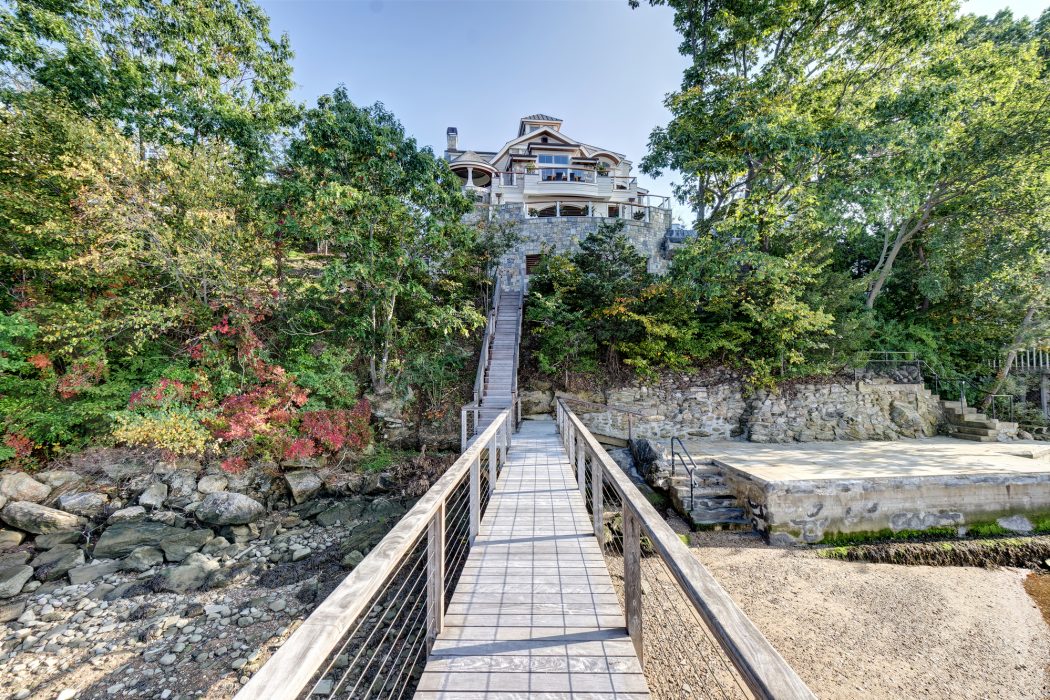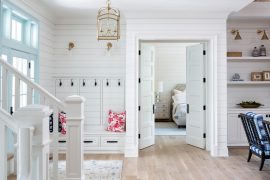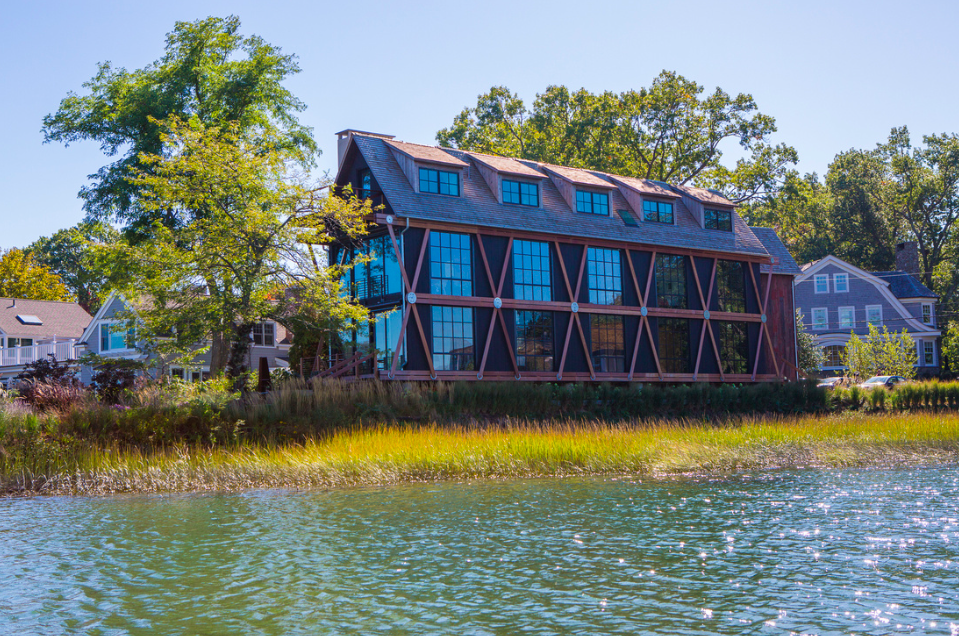Northern Italy meets New England in a Connecticut home built by the sea.
By Jennifer Sperry Photography by Jim Fuhrmann
For every construction challenge this Guilford, Connecticut, property presented, it delivered an equally dramatic reward. The long, narrow lot culminates in a rocky ledge perched over the banks of Long Island Sound. While this substrate of solid rock posed challenges for contractor Hallmark Associates, it provided a tantalizing blank slate for architect Nathan J. Topf, who merged New England vernacular with Tuscan influences to create a sensual seaside retreat.
The site’s sloping geography reminded Nate Topf, principal of Nathan J. Topf Architect, LLC, of a trip to Italy with his wife. “We stopped briefly at Lake Como, and I was immediately taken with the way the architecture there seems to grow out of the stone ledges. You see heavy, solid stone bases anchoring very light, beautiful, colorful architecture,” he describes. “It was such a clear picture of the Dark Ages transitioning into the Renaissance.”
Realizing the parallels between the topographies, and channeling this Italian inspiration, Topf designed his clients’ coastal home similarly: rooted solidly in rock, then rising up to capture sunlight and views. From the entry court, the home’s massing is purposefully restrained. “We reached peak building heights in many areas,” the architect notes of the town’s height restrictions. But to the rear, the structure blossoms with terraced indoor/outdoor spaces gracefully stepping down towards the shore.
“The entry elevation displays the timeless beauty of local Shingle Style architecture, while the waterfront elevation is more Tuscan in style,” explains Topf. “I wanted it to look like it grew naturally from the earth. On the water side, it sits very high and proud, with nearly 60 feet between the height of the roof and the lowest level.”
Purposeful volume changes—cozy rooms contrasted by soaring spaces—break down the home’s imposing scale. To Topf, each room is one stop along a carefully composed, well-orchestrated visual journey. For guests, the journey starts at the front entrance inside a modest foyer. After a couple steps, this comfy vestibule opens to a soaring double-height stair hall capped by a square cupola.
“Here, we really evoked the tradition of old seaside mansions with some darker woods and a richness of detailing,” notes Topf. Veteran interior designer Raymond Forehand, principal of Forehand + Partners, masterminded the home’s interior design, including the stair’s intricate balustrade.
“The second you walk in, you see straight through the house to the water views,” says Topf. “You connect with the ocean and the movement of the trees on the opposite side. It’s a large home but we incorporated as much transparency as possible.”
After the stair hall, the home’s scale contracts into a central corridor, which organizes some of the main floor’s quieter, more private spaces, including a formal dining room with domed ceiling. Then, Topf’s floor plan expands once again into the main living areas. Here, the architect unleashed his most dramatic gesture: a double cupola topping a central great room/dining area, flanked by the kitchen on one side and living room on the other.
Maximizing glazing without sacrificing the home’s architectural story was a primary concern of Topf, who opted for Marvin’s “Signature Ultimate” collection because of its extensive customization possibilities. “Their versatility in size and function as well as their quality of design protects the house even in the harshest of weather conditions,” he notes. “The window openings reflect the traditional scale of a Shingle Style house yet still transform the water-facing elevations with views and light.”
Michael Marroney, an outside sales rep for Ring’s End, Inc., a Connecticut-based building supply company, lent his own specialized expertise to the challenging project. “We were tasked with delivering top-of-the-line products that offer classic looks and cutting-edge performance for every aspect of the build,” says Marroney.
Marroney’s expertise aided the builder in achieving the architect’s spectacular window applications. Pushing the interior towards the view as much as possible, Topf capped off the main living area with a bonus sunroom, a riff on a more traditional New England-style screened porch. It pushes out from the main volume of the house towards the water in three directions, with clearstory windows maximizing the already impressive allotment of glazing.
To reduce the need for air conditioning, both cupolas were outfitted with banded operable Marvin windows. “Controlled remotely, these windows allow both sunlight and fresh air to reach deep into the house,” says Topf.
For the home’s water-facing elevations, Topf unleashed a predominance of stone, a nod to the site’s natural environment. Two terraces expand the home’s indoor-outdoor living with plenty of entertaining and sunning opportunities. French doors by Marvin connect the kitchen, living room, and sunroom with the main-level terrace. The lower-level terrace boasts a covered outdoor room with fireplace and a plunge infinity pool, poised 30 feet above the shore below.
Another Renaissance flourish is the property’s exterior helix stair situated within a stone turret. “This stair is a necessary transition between the main and lower levels and is one step along the way down to the dock,” says Topf. Punched openings in the turret walls are reminiscent of medieval arrow slits; their square shape welcomes light into the rotunda.
Architect: Nathan J. Topf, Architects
Builder: Hallmark Associates, hallmarkhomesassociates.com
Interior Designer: Forehand & Lake, forehandpartners.com
Material Supplier: Ring’s End, ringsend.com


















